|
|
|
|
Products mentioned in this Article
--None--
|
|
|
|
|
|
|
|
|
 |
|
|
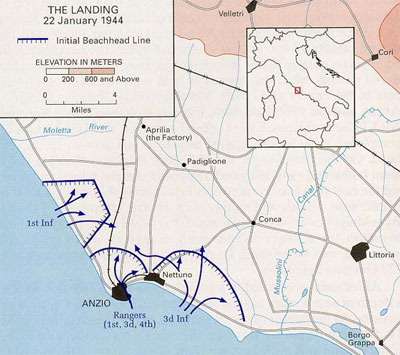 |
US Army Rangers at Cisterna di Latina
By Erik Mozolik
Rangers in the Mediterranean 1942-43...
On January 30, 1944 the 1st, 3rd and 4th Ranger battalions attempted to infiltrate the German held town of Cisterna di Latina to take what was meant to be a lightly held position occupied by second rate troops.
Unfortunately the town’s position in the hills overlooking Anzio made it an ideal staging point for the German counter-attack on the Anzio beachhead. The rangers advanced straight into the heavily occupied German positions.
To understand significance and the outcome of the battle of Cisterna di Latina, we must first look at the landings at Anzio.
|
Anzio
Not but days after these crucial decisions, the 6615th Ranger Force was to play a crucial role in the Anzio landings. The invasion was to be carried out by the 6th Corps, under the command of Major General John P. Lucas. The purpose of it was to threaten the rear of the Germans holding the Winter Line, forcing them to withdraw northward. The Germans holding the Winter Line were the German 10th Army, under the command of Lieutenant General Heinrich von Wietinghoff. The mission would call for landings at Anzio, and the seizing of Highways six and seven, major roadways that led to Rome. The highways themselves were within twenty miles of the Anzio beachhead.
|
|
The Rangers were given the mission of seizing the city’s port facilities and protecting them against sabotage, destroying nearby gun batteries, and clearing the beach area between Anzio and Nettuno, a neighbouring town. Their goal in this was to try to fill the gap between the landings of the British 1st division and the American 3rd Infantry division. After this, the Ranger Force would be attached to the 3rd Infantry division.
In actuality, the landings at Anzio were the smoothest the Rangers had ever taken part in. Their only opposition along the entire beach was two undermanned German coast-watching battalions to oppose the twenty-seven-battalion Allied force.
|
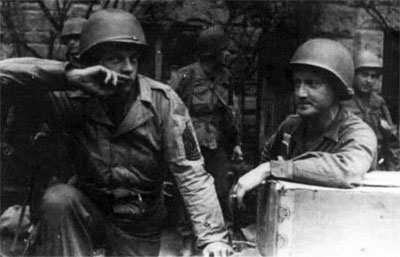 |
|
The Germans were there on leave from the Winter Line, and proved to
offer little resistance. By midnight the 6th Corp had landed about
36,000 men and 3,200 vehicles and had taken 227 prisoners at the cost
of 13 killed, 97 wounded, and 44 missing. The landings were undoubtedly
a success.
Over the next several days, 6th Corp slowly expanded along the beachhead. The Rangers aided the slow advance inland. While the army was slowly advancing, the Twelfth Air Force was bombing targets of opportunity throughout the area. Targets like bridges, munitions factories, and railways proved ample for the bombers. The town of Cisterna di Latina was very high on the list.
|
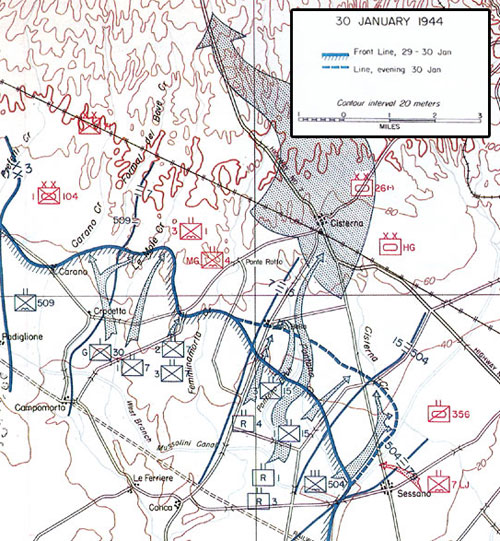 |
Cistern di Latina
Still part of the 3rd division, Darby and his men received new orders on the 28th of January. The order seemed basic: move out at 0100 on 30 January 1944, move rapidly to Cisterna, and seize and hold the town until relieved. Then the 3rd division would advance to the high ground around the town. Darby then handed down the order to his men.
The plan seemed simple and reasonable. The 1st Ranger battalion would follow a road into town, covered under darkness by previously reconnoitred routes. Since the terrain was open and flat, the Rangers intended to use the drainage ditches for concealment when possible in order to avoid enemy contact before reaching their objective. Upon entering the town the Rangers objective was to destroy what little resistance was left, occupy an area northwest of the town, and prepare to repel enemy counterattacks.
The 3rd Ranger battalion was to follow suit fifteen minutes after the 1st battalion.
|
If the enemy engaged the 1st battalion, it was to offer support, and eliminate the resistance, thus freeing the 1st Rangers to continue their attack on Cisterna. It would then help occupy the ground to the northwest, on a position just to the east of the 1st battalion. At 0200, the 4th Ranger battalion, with an eight-man minesweeping squadron attached, would depart for the town as well and advance along the Conca-Isola Bella-Cisterna road, clearing it of mines and any enemy resistance. The battalion would also work as a reserve unit, and be able to offer fire support, for the main party consisting of the 1st and 3rd Ranger battalions. The Rangers would also have the 83rd Chemical Mortar Battalion for additional fire support to the advancing units. It was to assemble along the road and be able to move forward to provide support. Intelligence had reported the town to be lightly held, and the total force of four battalions should have no trouble taking the town and any token resistance.
|
|
However, the intelligence was poor and the Rangers were mismatched against their foe.
The intelligence provided by the 3rd Infantry division was very optimistic, suggesting that Darby’s Ranger Force would accomplish its mission without undue difficulty. The German soldiers were beginning to show signs of exhaustion. This became evident by the frequent surrender of small Wehrmacht groups and the lack of aggressive patrolling which was attributed in part to the integration of Poles and other unreliable Axis allies into German units. The consensus based on the intelligence provided, was that the Wehrmacht units in and around the town of Cisterna were of lower quality than the Rangers were used to seeing, after battling in Sicily and Italy.
However, as the Rangers soon found out, intelligence was not accurate. While the men of the Ranger battalions were highly motivated and well trained, they were met by overwhelming odds in the battle at Cisterna. Intelligence proved disastrous, as the lightly armed Rangers would end up attacking the very area the Germans were staging for a counterattack. The Germans were sending several units into the area, including the 3rd Panzer Grenadier division, the 715th Motorized Infantry division, and the 4th Fallschirmjager division.
|
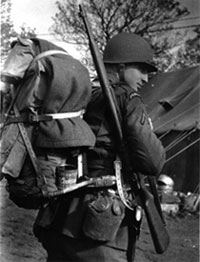
(Photo from Phil Stern collection)
|
|
By the next day, January 31st, armoured units of the Hermann Göring division also joined the attack.
The majority of the German troops that took part in the battle of Cisterna were from the 3rd Panzer Grenadier division, commanded by Major Rudolf Haen. The speed and mobility of Panzer Grenadier units would help them become more versatile and mobile on the battlefield. Armoured trucks and half-tracks proved well against infantry because of their armour and ability to carry light weaponry. They made excellent carriages for the MG-34 and MG-42 machine guns with their high rates of fire. The MG-42 was capable of firing 1,200 rounds per minute, and when fired, made a sound like ripping canvas. These mechanized infantry units proved to be an excellent quick-strike armoured unit often used in conjunction with Panzer tanks.
|
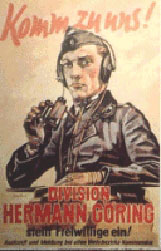 |
The next day, elements of the Hermann Göring division arrived with tanks, and the 2nd Parachute Lehr battalion, from the 4th Fallschirmjager division, joined the fray. The tanks were highly mobile and had heavy armour plating. Their guns and machine guns proved devastating against the pinned down Rangers.
All of these units were battle hardened and top rate in their class. The 3rd Panzer Grenadier division was initially sent to Italy in June of 1943. While there, it took part in the battles for Salerno and Cassino. Upon hearing the Allies invasion at Anzio, the division was rushed to Cisterna to prepare for a counter-attack. The 4th Fallschirmjager was actually comprised of the remnants of the elite 2nd Fallschirmjager division bolstered by polish troops and Italian Folgore paratroopers.
These German units were very strong, since they were being taken off active duty. The troops were battle hardened and their morale was very high. They were eager to launch a counteroffensive and send the Allies back to the sea off the Anzio beachhead.
A formidable foe, and the Rangers were no match against their armour and mobility.
|
|
The Rangers operated with the same equipment given to a standard light-infantry unit. Since the unit relied heavily on stealth and mobility on foot, the heaviest weapon the rangers had was the American bazooka. Most of the men carried semi-automatic rifles, carbines, or sub-machine guns. Other weapons included hand grenades, Browning Automatic Rifles, and Browning .30 caliber machine guns. These weapons were lightweight and carried a lot of firepower. While these weapons were excellent against infantry, they were no match for the armored units the Rangers fought against during the battle.
Also noted by several of the high-ranking Ranger officers was the decline in the quality of the men. Veteran solders that had been killed during front line fighting were being replaced by inadequately trained replacements. Often, their training had to be cut short to fill the gaps in the Ranger lines. During the battle of Cisterna, this lack of training, especially in nighttime operations, would prove disastrous.
The Attack
Finally, on the night of January 30, the Rangers began their assault. By 0215 the next morning, it had reached its jumping off point, an isolated house just to the right of the Conca-Isola Bella-Cisterna road. At the house, Colonel Darby set up his command post. He sent the 1st and 3rd battalions forward through a ditch towards the town. He waited for contact from his men on the progress of the mission.
|
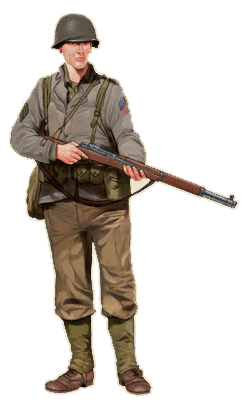 |
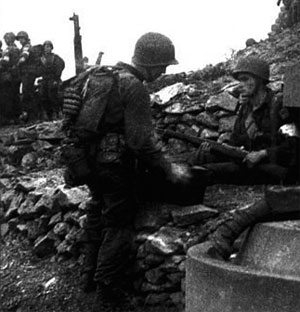 |
However, at 0215, several radio operators among the 3rd battalion reported themselves lost to the Force command post. The problem compounded itself when the 1st and 3rd battalions lost contact with each other halfway to their objective.
Unsure of what to do, Major Jack Dobson, commander of the 1st battalion, pressed on for half a mile. Here he stopped and made another critical error: he split his battalion in two, and continued forward with three companies toward the objective. Without knowing the status of the rest of 1st battalion and the entire 3rd battalion, Dobson pressed forward. This would leave the Ranger force at only one-fourth fighting strength when they initially reached the town The dangers of conducting a night infiltration with so many relatively untrained and inexperienced men were becoming painfully evident.
Unsure of what to do, the commander of the three remaining 1st battalion companies, Captain Charles Shunstrom, sent a runner back to try to find the 3rd battalion. The runner returned with startling information: Major Alvah Miller, who had recently been made the 3rd Ranger battalion commander, had been killed by a round from a German tank.
|
|
This meant that the Germans were alert, perhaps even prepared for an assault, yet they did not press the advantage and continue fighting with the 3rd battalion.
Meanwhile, the first three companies of 1st battalion pressed on. German patrols repeated crossed in front of and on both sides of the advancing men. The point platoon, led by Lieutenant James Fowler, surprised two groups of German sentries and killed them with knives and bayonets. At 0545, when dawn was beginning to break, the three companies passed close enough to an enemy artillery battery to hear the gunners’ voices. The men tried to radio Colonel Darby, but repeatedly failed and still pressed on farther without knowing the whereabouts of the rest of the 1st battalion and the entire 3rd battalion.
The three companies reached a large flat field just south of the town.
Right: The terrain leading to Cisterna di Latina.
|
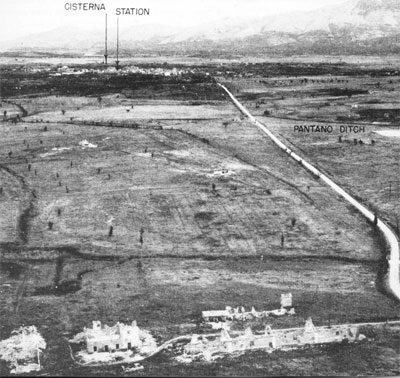 |
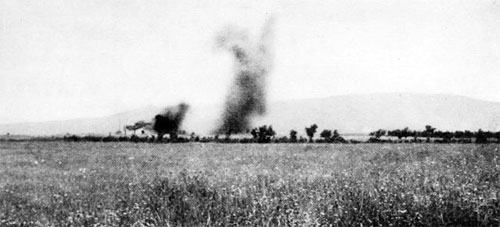 |
The field was roughly triangular in shape; about a thousand yards long
on each side, and surrounded and subdivided by roads and drainage
ditches. At this, the Rangers broke into a run in order to reach the town before the sun rose.
Left: The terrain around Cisterna di Latina was fairly open making the darkness the Rangers only source of concealment for most of the battle.
|
| Within 600 yards of the outskirts of town, they
passed through what seemed to be a German bivouac area and killed a
large number of the surprised enemy with bayonets and knives. When they
had reached within 400 yards of the town, the entire field became a
storm of bullets coming from the town itself. The Rangers sought cover
in an irrigation ditch running parallel to a small road and returned
fire with their small arms and bazookas. |
|
While this was happening, the remaining companies of the 1st battalion and the 3rd battalion were slowly advancing toward Cisterna. They were able to get within 300 yards of the three lead companies, before running into more German defenders. After the Rangers destroyed two tanks with bazookas, they were able to make contact with the three lead companies.
At this time, the 4th Ranger battalion began its assault up the Conca-Isola Bella-Cisterna road. However, they were stopped by a hail of fire from German tanks, half-tracks, automatic weapons, and small arms. Darby, still in contact with his 4th battalion, saw an urgent need to break through the roadblock to ensure the survival of the 1st and 3rd battalions. Obviously, Cisterna was more strongly held than anyone had anticipated.
Although it was not realized at the time, the events at Cisterna were the results of planning by the German high command and by the poor intelligence of the Americans. General Field Marshal Albert Kesselring, the senior German commander of Italy, was right in judging that Major General John Lucas, commander of the 6th Corp, would move cautiously. He was correct in assuming that Lucas would not move into the hills and off the beachhead right away, and planned a counterattack, scheduled for 2 February. The planned counterattack went unnoticed by Allied planners who interpreted German intentions in the area to be purely defensive.
|
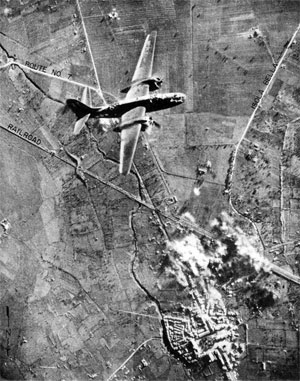 |
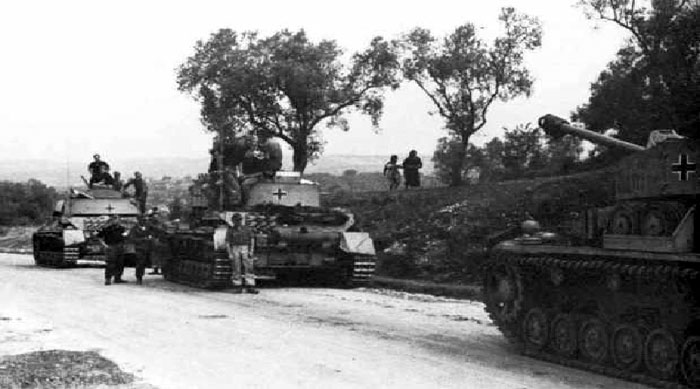 |
Even more ironic, however, is the fact that a young Pole named Stempkofski, tried to tip off the Americans to the German preparations at Cisterna. Stempkofski deserted to American troops and tried to tell them what was happening, but they evacuated him to the rear and his story was not known until after the battle when he was routinely interrogated at 5th Army headquarters. What warning the Allies did receive arrived too late to help Darby and his men battling at Cisterna.
|
| What else was unknown was that the German army had detected the Rangers as they moved northward. They were spotted when they got within a mile of the triangular field. The Germans had detected the Rangers and let them pass. Obviously, the Rangers were walking into a trap. |
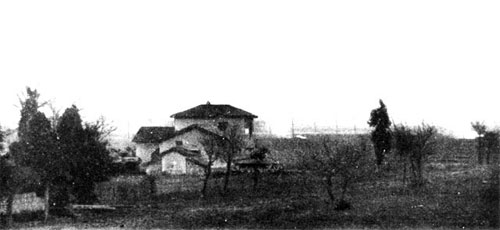 |
By this time, three tanks approached the rear of the two battalions caught in the field. The Rangers were being surrounded. The tanks were systematically destroyed with bazookas, but automatic and small arms fire continued to tear through the Rangers, most of whom were gathering in an area about three hundred yards in diameter. For two hours the Germans tried overrunning the Rangers, and the Rangers tried to break out of the encirclement.
|
|
Both attempts were turned back with mutual
ferocity. After two hours, ammunition was running short, so three
reserve companies split half of their remaining ammunition with those
Rangers in the front.
The Germans grew in strength as the 2nd Parachute Lehr battalion joined the attack, and German artillery began to fire at point-blank range. The Rangers repeatedly called for help on the radio, but again, the attempts were useless. While some messages began to get through, it didn’t matter because Darby and the rest of the Ranger Force had been fought to a standstill along the Conca-Isola Bella-Cisterna road. Chances for getting help for the two isolated battalions seemed to wither every minute that passed.
|
|
Around 1200, German paratroopers from the 2nd Parachute Lehr battalion supported by armoured personnel carriers began marching about a dozen captured Rangers toward the centre of the 1st and 3rd Ranger Battalions’ position. This was done in order to entice the Americans to surrender. However, when Ranger marksmen shot two of the Germans, the Germans retaliated by bayoneting two Ranger prisoners. They continued to march the prisoners forward.
At this time, along the road leading to town, the 83rd Chemical Mortar battalion was put into action. In order to hold the line, B Company became the infantry and established a defensive position, while A Company fired heavily with their mortars.
|
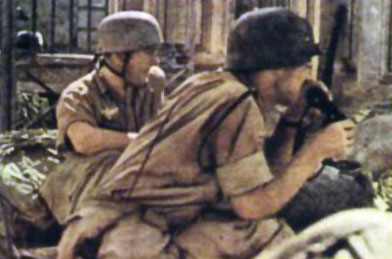 |
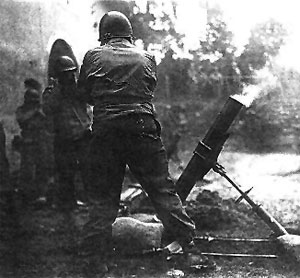 |
The B Company infantry sent out patrols to try
to establish a link with the 1st and 3rd Ranger battalions, while the A
Company poured heavy fire down the road at the Germans engaging the 4th
Ranger battalion. Between the mortar fire and aggressive action of B
Company, the 4th Ranger Battalion was able to conduct an orderly
withdrawal.
Back in the triangular field, the same hostage sequence was repeated again, and two more Germans were shot and two more prisoners were bayoneted. More Rangers were being captured or surrendered. For the third time, Ranger prisoners, now numbering almost eighty, were marched toward the centre of the Ranger position. Again, Rangers opened fire on the guards, but when several prisoners were accidentally killed along with one or two Germans, a few men who were evidently new to combat got hysterical and started to leave their positions and surrender. Although ordered not to give up, many continued to do so in the piecemeal surrender that continued.
|
The Rangers that stayed prepared for their imminent defeat. Some men disassembled their weapons and buried or scattered key parts before the Germans overran the area. Others destroyed radios after telling Darby what was happening. Colonel Darby, still at the house along the Conca-Isola Bella-Cisterna road, received a last transmission from Sergeant Major Robert Ehalt of the 1st Ranger battalion. Ehalt informed Darby that both the commanders from the 1st and 3rd Ranger battalions were dead, along with the executive officer of the 3rd Ranger battalion. He reported that he had only five men left, and Germans tanks were swarming the battlefield.
|
|
Darby tried valiantly, to try to dislodge his troops being surrounded at Cisterna. However, his taskforce was too small for the job. Darby, his 4th Ranger battalion, and the 83rd Chemical Mortar battalion did all they could, but it was not enough to prevent the disaster that occurred. By the end of the day, due to repeated rescue attempts, Darby’s remaining battalion, 4th Ranger battalion, was left at half strength. The rest of the men were either killed or injured.
The Rangers left in the field formed small pockets of resistance; much like Ehart did, and continued fighting. However, the heavily equipped Germans, using the farmers’ roads in the fields for their tanks and half-tracks, broke the Rangers into smaller groups.
One by one, each pocket of resistance was systematically crushed. By the end of the day, January 31, 1944, the 1st and 3rd Ranger battalions were no more. Only six men of the entire 767-man force made it back to friendly lines. Two entire battalions had been annihilated, and all the others had been killed or captured. Along with this, the 4th Ranger battalion lost half of its effective strength. In one swift move at Cisterna, the Germans had eliminated half of the Unites States Ranger forces of World War II.
|
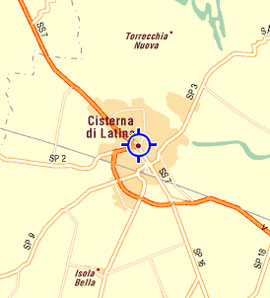 |
|
Reasons for failure
Many factors lead to the loss at Cisterna. What seems right to say is that poor intelligence is a main factor. Although sufficient information had been collected to correctly determine the enemy’s capabilities and probable course of action, they had been sorely misjudged. Allied intelligence and planning, especially among the 3rd Infantry division, can be blamed for not anticipating the German army as well as the Germans had anticipated the Allied move to Cisterna.
Intelligence officers among the 3rd Infantry division dismissed the build-up of German forces as a defensive move. However, the main units being moved into the area were crack Wehrmacht units with extreme offensive capabilities. Tanks and armoured personnel carriers were used in the German blitzkrieg as fast and powerful weapons of the battlefield. They sorely misjudged the German units being moved into the area around Cisterna.
While intelligence played a role in the outcome of the battle, so did the Rangers themselves. The decline in the Rangers’ combat skills resulted as an unfortunate misuse of their forces. From North Africa, through Sicily, and up to Italy, the Rangers had too frequently been used as conventional infantry, which is not the purpose of their organization. Most of the casualties that they did suffer during this time were because of their extended time serving as a line unit, and these were casualties the Rangers could not afford. As the casualties were being replaced with often ill trained men (by Ranger standards), the quality of their force became lower, their combat skills declined, their unit cohesion suffered, and most importantly, there was a lack of good unit commanders. This deterioration is evident throughout the battle.
|
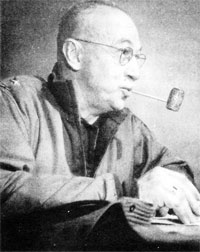 |
The lack of good leadership can be traced all the way up to Major General John P. Lucas, commanding the 6th Corps. Had the 6th Corp not been lax under his timid leadership, the Corps may have advanced much farther inland, and thus deprived the Wehrmacht of even assembling the counterattack force at Cisterna in the first place. Lucas was slow to exploit the landing and didn’t fully assess German assets in the area.
Although the Ranger force suffered a disaster at Cisterna, it is arguable that it gave the Allied forces at Anzio two badly needed days to prepare for the German counterattack. Darby’s men, at the cost of their own lives, gave the 6th Corp and Major General Lucas around Anzio precious time to prepare for the counterattack.
As it was, the Germans delayed their attack until February 4, and even then, it almost defeated the Americans at Anzio. If Darby’s men among the 1st and 3rd Ranger battalions had not given their lives, it causes wonder as to the outcome of the planned counterattack on February 4th.
|
While it is debatable as to the effect Darby’s men had on the German counterattack, the battle of Cisterna undoubtedly caused the end of Darby’s Rangers.
What was left of the 4th Ranger battalion was temporarily attached to the Canadian-American 1st Special Service Force. Those Rangers that had spent considerable time overseas were sent back to the United States, where on October 24 the 1st, 3rd, and 4th Ranger battalions were inactivated. The men who had more recently joined the Rangers were attached to the 1st Special Service Force.
The battle of Cisterna di Latina had a tremendous impact on the war, and a tremendous impact on the United States Ranger force. As stated, at the outcome of the battle, the overall Ranger strength during the war was cut in half. Because a major factor of their defeat at Cisterna was due to a decline in the quality of the troops, future conflicts would be changed as commanders sought better ways to implement the Rangers into their task force.
|
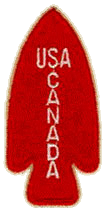 |
No longer would the Rangers be used as a line unit. The Rangers had proven themselves to be an elite fighting unit in World War II, and that role in conflict is unchanged today. From that point on, Rangers always lead the way.
|
Last Updated On Tuesday, June 19, 2007 by SuperUser Account
|
|
|